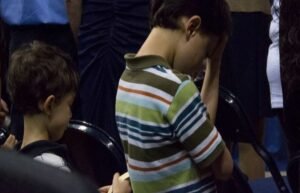
When I was a child growing up in an Evangelical church, preachers and revivalists during the time of “invitation” would say, “Every head bowed and every eye closed.” They would then plead with those who were “not saved” to come forward and make their “profession of faith.” Even as a child, I resented being told to bow my head and close my eyes during this time of “invitation.” I cannot abide manipulation.
The typical stance for prayer in church is head bowed and eyes closed. Various reasons have been given for this stance: respect for the sovereignty and holiness of God; not allowing our eyes to wander and become distracted by things of this world; a sign of penitence and subjection to God who alone can forgive our sin and grant us grace.
However, in the early church, bowing one’s head while praying was a sign of shame. It also implied that the way to God was necessarily inward. Those early Christians saw God in everything in creation. And they saw themselves as human beings made in the image of God and in Christ as the adopted children and joint heirs with Christ. The glory of God was revealed in the majesty, wonder, and mystery of creation and in the unique qualities of each human being who reflected the divine image. Those early Christians could look into each other’s eyes and see God because God in Christ dwelt in them. They took Paul seriously when he wrote that Christ “is the image of the invisible God, the first-born of all creation; for in him all things were created, in heaven and on earth, visible and invisible…all things were created through him and for him. He is before all things, and in him all things hold together. He is the head of the body, the church; he is the beginning, the first-born from the dead, that in everything he might be preeminent. For in him all the fulness of God was pleased to dwell, and through him to reconcile to himself all things, whether on earth or in heaven.” (Colossians 1)
God could be found in creation and in other human beings. The inward path to God with eyes closed and head bowed can facilitate meditation and allow for profound insight and experiences of communion with the Divine. However, when that becomes the only stance in our prayer life, it can lead to a lack of awareness of the presence of God in creation and one another. Elsewhere, Paul wrote, “Pray always.” As he made his tents, I doubt if he had his head bowed and eyes closed. He meant we should always have a sense of the presence of God and be open to that presence through the sacramental nature of creation and our fellow humans created in God’s image.
Imagine what it would be like if a congregation prayed with everyone’s head raised and eyes open seeing, not just looking but actually seeing, each other through the lens of wondrous love.
Imagine what it would be like if a congregation prayed with everyone’s head raised and eyes open seeing, not just looking but actually seeing, each other through the lens of wondrous love. If God’s love is truly unconditional, indiscriminate, and all embracing, we are all precious to God. And if Christ dwells within us, we are each an altar where the Risen Christ can be encountered.
God is not just found in a book, in our hearts, or even in a church. God is found in the work of Her hands and heart, and we are a unique part of that handiwork. Jesus tells us that he is to be found in “the least of these” according to the world’s standards. He is present everywhere. So yes, there are probably times when we should pray with our heads bowed and our eyes closed. But when that stance becomes the only way we pray, more than likely we will miss so many parts of this world “God so loves.” And when we overlook whom and what God loves, I think we have just lost the plot of being humans made in God’s image.




